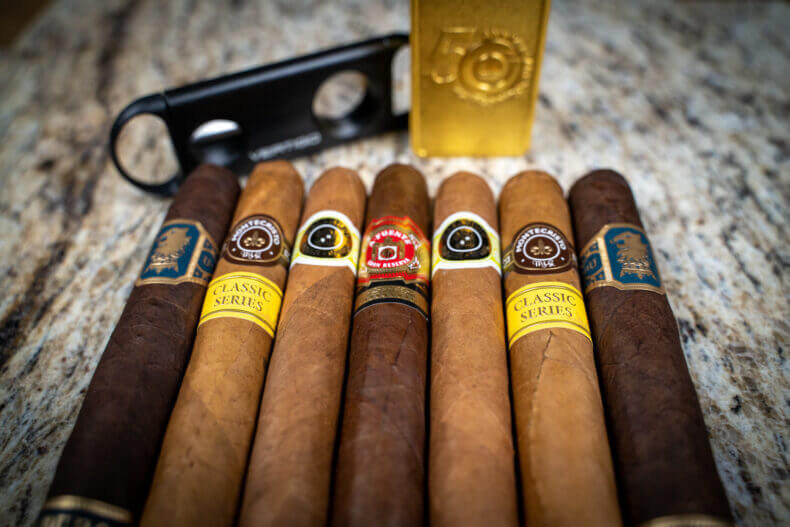Regular cigar smokers will likely have encountered the term “stogie” at one point or another. But what is a stogie and how does it differ from the traditional cigar with its three components — a filler, a binder, and a wrapper? Let’s explore the origins of both terms and clarify what a stogie is.
What are stogies?
If smoking is a pastime you’ve recently discovered, cigar lounges and shops will point you toward a classic stogie. This is because it’s important not to overwhelm a beginner’s palate with an expensive, chunky cigar or strong, rich flavors.
While stogie is slang for pretty much any type of cigar (except for a Cuban smoke), it’s historically used to describe a thin, long, cheap, and pre-cut cigar. This is why stogies provide beginners with a great introduction to cigars when it comes to lighting their inaugural puff.
Stogies will burn hotter and faster than a thick cigar and, in many cases, are light on the palate. The thin construction of a stogie means the wrapper accounts for a greater portion of the blend, so a luscious-tasting wrapper can dramatically alter the flavor profile.
Never refer to a special occasion or premium cigar as a “stogie,” especially not in front of a seasoned cigar smoker, as it’s bad cigar etiquette and can be insulting to the industry.
What is a cigar?
Bigger than a cigarette and taking much longer to smoke, cigars are a tightly-rolled filler blend of cured tobacco leaves with an outer covering of tobacco leaf wrapper. The binder is used to keep the filler tobacco together.
There are two classic cigar shape categories — Parejo and Figurado. Each shape within these categories differs slightly and are broken down into various sizes, such as Robusto or Toro.
While there is no correlation between the size of a cigar and its strength, a thicker cigar will burn more slowly and coolly. This is one of the main reasons it will take longer to smoke than a stogie cigar.
The taste can also vary depending on the size of your stick. A larger cigar will naturally be packed with more filler tobacco than a stogie, so even the same tobacco blends can be interpreted differently, subject to the burn time. A longer cigar will likely provide a more complex smoking experience, so it is best enjoyed when you have time — especially to pick out subtle tasting notes.
Why are cigars called stogies?
It’s worth noting some people refer to a premium cigar as a stogie, but the term’s origin suggests otherwise. Stogie is an abbreviation for Conestoga — a small township in Lancaster County, Pennsylvania. This is where these cheap, rough-looking, and long, thin cigars became popular.
Smoked by drivers of Conestoga wagons in the 1700s and 1800s, stogies were commonly lit up on long journeys, with the wagons capable of covering 12 to 14 miles per day. These rugged sticks were self-made, resembled the spokes of wagon wheels, and were rolled from Pennsylvania tobaccos tied up with rope.
Before it became synonymous with the cigar industry, the term stogie was associated with the durable shoes the wagon drivers wore during the days of the Gold Rush. This period saw a significant increase in wagon drivers, and the easiest way to make them more memorable was to use a simple nickname. Cue the drivers and their thick-soled shoes taking the stogie moniker.
It was only once wagon activity had slowed down that the stogie nickname was transferred to the long, thin cigars enjoyed by the drivers. Over the next few years, the shoe reference was erased completely, and the term was solely applied to cigars.
Lancaster County was one of the USA’s leading tobacco producers, responsible for 65% of the state’s tobacco by 1859. While Pennsylvania Broadleaf tobacco is still harvested there, this part of the world can lay claim to being the reason why many today are familiar with a stogie cigar.
In 1840, stogies were further cemented into American culture through the unveiling of the brand Marsh Wheeling. It was the oldest cigar manufacturing company founded in the US and a self-described stogie.
Stogie vs cigar
Stogies certainly have their place in the cigar industry, but it’s important not to presume they are poor quality. They serve a purpose at the lower end of a cigar smoker’s budget, offering an affordable smoke that requires little maintenance or preparation.
Because the term is now more widespread, you must be clear with your desires when asking for a true stogie cigar, aka a cheap, beginner-friendly cigar.
